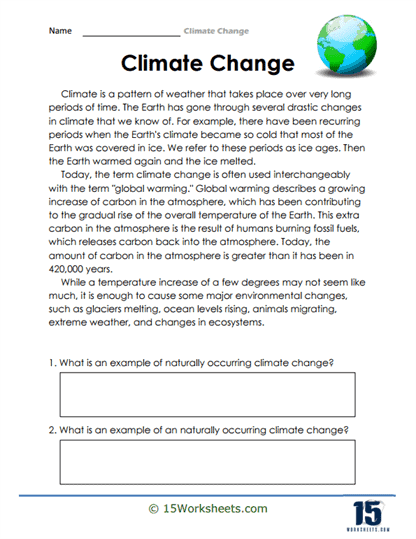Natural or Unnatural

Worksheet Description
The worksheet provides text that looks into the nature of climate, detailing its long-term shifts and emphasizing the current concerns regarding global warming. The text elaborates on how the Earth’s climate has historically oscillated between cold and warm periods and underscores the recent increase in atmospheric carbon due to human activities, leading to significant environmental repercussions. Accompanying the text are two questions that prompt students to identify examples of naturally occurring climate change.
To effectively engage with this worksheet, students should commence by carefully reading the provided passage, ensuring they understand the key points related to climate fluctuations and the role of human-induced carbon emissions. After thoroughly digesting the content, students can then reference specific portions of the text to identify and note down examples of natural climate changes. It might also be beneficial for students to underline or highlight pertinent sections of the text for ease of future reference.
The primary objective of this worksheet is to instill a foundational understanding of the concept of climate change, emphasizing both its natural occurrences throughout history and the current accelerated changes due to human intervention. By presenting a mix of historical context and present-day implications, the worksheet aims to foster critical thinking on the topic. The questions at the end serve to reinforce students’ comprehension and ensure they can discern between natural and anthropogenic factors influencing the climate. Through this exercise, learners are encouraged to appreciate the depth and urgency of the current climate crisis in the context of Earth’s extensive climatic history.
Climate is a pattern of weather that takes place over very long periods of time. The Earth has gone through several drastic changes in climate that we know of. For example, there have been recurring periods when the Earth’s climate became so cold that most of the Earth was covered in ice. We refer to these periods as ice ages. Then the Earth warmed again, and the ice melted.
While a temperature increase of a few degrees may not seem like much, it is enough to cause some major environmental changes, such as glaciers melting, ocean levels rising, animals migrating, extreme weather, and changes in ecosystems.
What is an example of naturally occurring climate change? Give an example.
